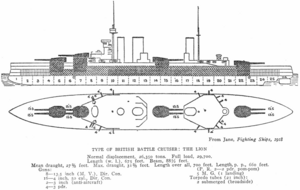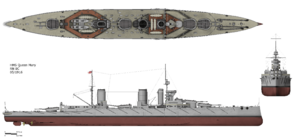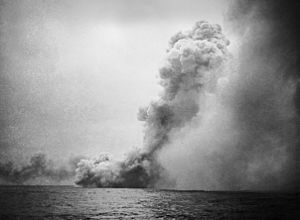HMS Queen Mary facts for kids

Queen Mary at sea with torpedo net booms folded against her side
|
|
Quick facts for kids Class overview |
|
|---|---|
| Operators: | |
| Preceded by: | Lion class |
| Succeeded by: | HMS Tiger |
| Built: | 1911–1913 |
| In commission: | 1913–1916 |
| Completed: | 1 |
| Lost: | 1 |
| History | |
| Name | Queen Mary |
| Namesake | Queen Mary, consort of George V |
| Ordered | 1910–1911 Naval Programme |
| Builder | Palmers Shipbuilding and Iron Company, Jarrow |
| Laid down | 6 March 1911 |
| Launched | 20 March 1912 |
| Completed | August 1913 |
| Commissioned | 4 September 1913 |
| Fate | Sunk during the Battle of Jutland, 31 May 1916 |
| General characteristics | |
| Type | Battlecruiser |
| Displacement | |
| Length | 700 ft 1 in (213.4 m) |
| Beam | 89 ft 1 in (27.2 m) |
| Draught | 32 ft 4 in (9.9 m) at deep load |
| Installed power | |
| Propulsion | 4 shafts, 2 direct-drive steam turbines |
| Speed | 28 knots (51.9 km/h; 32.2 mph) |
| Range | 5,610 nmi (10,390 km; 6,460 mi) at 10 knots (18.5 km/h; 11.5 mph) |
| Complement |
|
| Armament |
|
| Armour |
|
HMS Queen Mary was a powerful warship called a battlecruiser. It was the last one built for the Royal Navy before World War I began. This ship was unique, being the only one of its kind. However, it shared many features with the earlier Lion-class battlecruisers. Queen Mary had eight large 13.5-inch guns.
The ship was finished in 1913. It joined the Grand Fleet and took part in the Battle of Heligoland Bight (1914) in 1914. Like other modern British battlecruisers, Queen Mary stayed in the North Sea during the war. It was part of the 1st Battlecruiser Squadron. In December 1914, Queen Mary tried to stop a German attack on the English coast, but it didn't succeed.
In early 1915, the ship was being repaired and missed the Battle of Dogger Bank (1915). But in mid-1916, it fought in the biggest naval battle of the war, the Battle of Jutland. During this battle, Queen Mary was hit twice by the German battlecruiser Derfflinger. Soon after, its ammunition storage areas (magazines) exploded, causing the ship to sink.
The wreck of Queen Mary was found in 1991. It lies in pieces on the bottom of the North Sea. The site is protected by law because it is the grave of 1,266 sailors.
Contents
Building the Queen Mary
Queen Mary was ordered as part of the 1910–11 Naval Programme. Usually, only one battlecruiser was ordered at a time. This ship was different from the earlier Lion-class ships. Its smaller guns and armour were placed differently. Also, the officers' living areas were moved. On Queen Mary, these areas were put back in the traditional spot at the back of the ship. This was after sailors complained about them being in the middle. Queen Mary was also the first battlecruiser to have a special walk area at the very back.
The ship was named after Mary of Teck, who was the wife of King George V. Her representative attended the ship's naming ceremony on March 20, 1912.
Ship's Size and Crew
Queen Mary was a bit bigger than the Lion-class ships. It was 700 feet 1 inch (213.4 m) long. Its width (beam) was 89 feet 1 inch (27.2 m). The ship sat 32 feet 4 inches (9.9 m) deep in the water when fully loaded. Normally, the ship weighed about 26,770 long tons (27,200 t). When fully loaded, it weighed 31,650 long tons (32,160 t). This was over 1,000 long tons (1,016 t) more than the earlier ships.
In peacetime, the crew had 997 officers and sailors. During wartime, this number increased to 1,275 people.
How the Ship Moved
The Queen Mary had two sets of steam turbine engines. These engines were in separate rooms. Each set had a high-pressure turbine and a low-pressure turbine. The turbines were designed to produce 75,000 shaft horsepower (56,000 kW) of power. This was 5,000 shp (3,700 kW) more than the previous ships.
During tests in 1913, Queen Mary produced over 83,000 shp (62,000 kW) of power. It could reach a speed of 28 knots (52 km/h; 32 mph). The ship used 42 Yarrow boilers to create steam. It could carry 3,600 long tons (3,660 t) of coal and 1,170 long tons (1,190 t) of fuel oil. The oil was sprayed on the coal to help it burn faster. The ship could travel 5,610 nautical miles (10,390 km; 6,460 mi) at a speed of 10 knots (19 km/h; 12 mph).
Ship's Weapons

Queen Mary had eight large 13.5-inch guns. These guns were in four turrets, with two guns in each turret. The turrets were named 'A', 'B', 'Q', and 'X' from front to back. These guns could shoot heavy 1,400-pound shells. They could fire 1.5 to 2 rounds per minute. The ship carried 880 shells for these main guns.
For smaller targets, it had sixteen 4-inch guns. Most of these were in protected areas on the ship's deck. These guns fired 31-pound shells.
At first, the ship had no anti-aircraft guns. But in October 1914, two were added. One was a 6-pounder gun, and the other was a 3-inch gun. These were used to shoot at aircraft.
The ship also had two 21-inch torpedo tubes. These were underwater, one on each side. It carried 14 torpedoes. Each torpedo had a warhead with 400 pounds of TNT. They could hit targets up to 4,500 yards (4,115 m) away at high speed.
Aiming the Guns
Before World War I, how ships aimed their guns improved a lot. Queen Mary had a special system to help aim. It used a rangefinder to measure how far away the target was. This information went to a computer that calculated how to aim the guns. This helped the gunnery officer predict where the enemy ship would move.
A new system called a "director firing system" was a big step forward. A director was placed high on the ship. It sent electrical signals to the gun turrets. These signals told the crew how to aim their guns. All the guns could then fire at the same time. This made it easier to see where the shells landed. Queen Mary received this new director system before the Battle of Jutland.
Ship's Protection (Armour)
The Queen Mary had strong armour to protect it. Its main armour belt was 9 inches thick. This belt covered the most important parts of the ship. It was thinner at the front and back. There was also an upper armour belt, up to 6 inches thick.
Strong steel walls, called bulkheads, were 4 inches thick. These closed off the armoured area. The gun turrets had 9-inch thick fronts and sides. Their roofs were also very thick. The areas holding the turrets (barbettes) were protected by 9 inches of armour. The ship's decks had armour from 1 to 2.5 inches thick. The command centre (conning tower) had 10-inch thick sides.
Special steel walls, 2.5 inches thick, were placed near the ammunition rooms. These were called torpedo bulkheads. They were designed to protect against torpedo attacks.
Service in World War I
Queen Mary was built at Palmers Shipbuilding and Iron Company. It was laid down on March 6, 1911. The ship was launched on March 20, 1912. It was finished in August 1913. The total cost was about £2.07 million.
Captain Reginald Hall took command on July 1, 1913. The ship officially joined the navy on September 4. Queen Mary was part of the 1st Battlecruiser Squadron. This squadron was led by Rear Admiral David Beatty. In 1914, Queen Mary visited Brest, France, and Russia.
Battle of Heligoland Bight
Queen Mary's first battle was on August 28, 1914. This was the Battle of Heligoland Bight. Beatty's battlecruisers were meant to support British smaller ships. They were there in case large German ships came out.
At 12:37 PM, Beatty's battlecruisers appeared from the mist. They found the German light cruisers SMS Strassburg and SMS Cöln. Strassburg escaped into the mist. But Cöln was hit badly by the British ships. Beatty then chased and destroyed another German cruiser, SMS Ariadne. After this, Beatty ordered his ships to turn back north. On the way, they found the damaged Cöln again. It was then sunk by Lion.
Raid on Scarborough
The German Navy wanted to attack British towns on the North Sea coast. They hoped this would draw out the Royal Navy. Then, they could destroy parts of it. Admiral Franz von Hipper planned a large attack. His fast battlecruisers would bombard the towns. The main German fleet would wait to protect them.
The British, however, were reading German naval codes. They knew about the raid and planned to trap the German ships. Beatty's 1st Battlecruiser Squadron was sent to stop the Germans. By this time, Captain C. I. Prowse commanded Queen Mary.
On December 15, 1914, Hipper attacked several English towns. But British destroyers had already met German destroyers. There was some confusion in British communications. This allowed some German ships to escape. Hipper's battlecruisers also managed to get away. Queen Mary was being repaired in early 1915. So, it missed the Battle of Dogger Bank (1915).
Battle of Jutland
On May 31, 1916, Queen Mary sailed with the Battlecruiser Fleet. Their mission was to stop the German fleet. The British had decoded German radio messages. So, they left their bases before the Germans.
At 3:20 PM, German battlecruisers spotted the British fleet. Two minutes later, Beatty ordered his ships to prepare for battle. Hipper turned his ships away from the British. He wanted to meet up with the main German fleet. Beatty changed course to cut off Hipper.
At 3:48 PM, the German ships opened fire first. The British ships were still turning. The German shots were accurate. Queen Mary began firing at the German ship SMS Seydlitz around 3:50 PM. By 3:54 PM, the ships were closer. Queen Mary hit Seydlitz twice. One hit caused a fire in its ammunition area.
The distance between the ships became too great for accurate shooting. Beatty ordered his ships to get closer again. This move put Lion in danger. Smoke from hits on Lion made SMS Derfflinger lose sight of it. So, Derfflinger started firing at Queen Mary. This was around 4:16 PM.
Queen Mary hit Seydlitz again at 4:17 PM. But Queen Mary was hit twice by Seydlitz. One hit damaged its 'Q' turret. By 4:25 PM, the ships were very close. Beatty tried to increase the distance again. But it was too late for Queen Mary.
Derfflinger hit Queen Mary twice just before 4:26 PM. One shell hit the front of the ship. It caused one or both of the front ammunition magazines to explode. This broke the ship in two near the front mast. A midshipman named Jocelyn Storey survived. He was inside 'Q' turret. He reported a huge explosion at the front. It shook the turret and broke one of its guns. Another explosion, possibly from shells, shook the back of the ship. The ship then rolled over and sank.
Tiger, the ship behind Queen Mary, was covered in debris. It had to steer away to avoid the sinking ship. A total of 1,266 sailors were lost. Eighteen survivors were rescued by British destroyers. Two more were picked up by the Germans.
What Happened After
Queen Mary is now a protected site. This is under the Protection of Military Remains Act 1986. This law helps prevent further damage to the ship. It is the resting place for 1,266 officers and men.
Surveys of the wreck were done in 2001–2003. They showed the ship is in three main pieces. The front two parts are heavily damaged. The back part is upside down but mostly complete. Its propellers were removed. Experts believe the first explosion was not in the main gun magazines. Instead, it was likely in the magazine for the smaller 4-inch guns. This explosion would have been strong enough to break the ship in half. The blast then spread to the front main magazine, tearing the front section apart.




